The 1973 quarter nickel is an old coin. This coin is already 50 years old at the time of this writing. With this age, the 1973 quarter is an interesting coin to add to your collection.
So, you might wonder, what is the 1973 quarter? How much would it cost me to buy it? Would anyone be willing to buy it if I sell one? What is its composition, historical background, or design?
We are going to answer all these questions today. Read on to learn more about the 1973 quarter.
What Is the 1973 Washington Quarter Made Of?
The 1973 Washington quarter is made of 75% copper and 25% nickel. This has been the composition of the Washington Quarter since 1965 when the US Mint transitioned to using base metals instead of silver. The move was done to discourage people from hoarding silver coins and to lower the cost of manufacturing coins.
The 1973 quarter is part of the Washington Quarter series first struck in 1932. The United States was going through the Great Depression in the late 20s and early 30s. So, minting a new coin wasn’t their priority at that time.
However, 1932 marked the 200th birth anniversary of the country’s first president, George Washington. So, it was a significant event that was too difficult not to commemorate. US Mint officials celebrated the occasion by adding Washington to a US coin.
Initially, the plan was to add Washington to the half-dollar coin. Later, they changed their mind and used the quarter coin instead.
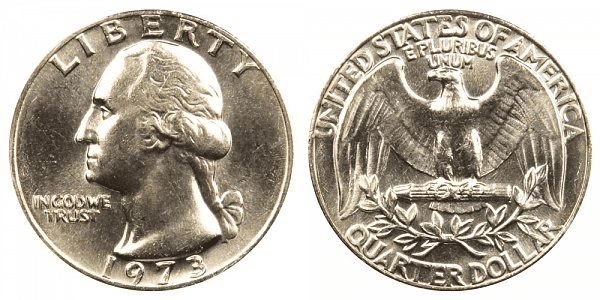
When it comes to design, the obverse of the 1973 quarter features the left profile of George Washington along with the inscriptions LIBERTY, IN GOD WE TRUST, and 1973.
On the reverse, you’ll find a heraldic eagle spreading its wings while clutching a bundle of arrows in its talon. Under the arrows is an olive branch. Inscriptions include UNITED STATES, E PLURIBUS UNUM, and QUARTER DOLLAR. The mint mark can also be found on the reverse. If present, it is found under the olive branch.
Choosing the design of the new Washington Quarter was controversial. The US Mint at that time held a design competition. Almost 100 artists participated.
At first, it seemed that the clear winner was Laura Gardin Fraser. She was a talented artist known for her beautiful commemorative coin designs. The Commission liked the design of Fraser. However, Andrew Mellon, the then-Treasury Secretary, disapproved of her work. Instead, he chose John Flanagan’s design, which was initially difficult to mint.
Nevertheless, despite the controversial beginning of the Washington Quarter, there’s no doubt that it is among the most popular US coins today.
1973 Washington Quarter Varieties
The 1973 Washington Quarter comes in three varieties. These are the following:
| Variety | Mint Location | Mintage |
| 1973 P Washington Quarter | Philadelphia | 346,924,000 |
| 1973 D Washington Quarter | Denver | 232,977,400 |
| 1973 S Proof Washington Quarter | San Francisco | 2,760,339 |
| Total | 582,661,739 |
The mints in Philadelphia and Denver worked together to produce regular coins, while the San Francisco Mint produced proof coins. At the end of 1973, more than 582 million Washington quarters were produced.
Below, you’ll find more details about each of the 1973 quarter varieties.
1973 P Washington Quarter
Year of minting: 1973
Mint Mark: none
Place of minting: Philadelphia
Quantity produced: 346,924,000
Face Value: $0.25 (twenty-five cents)
Price: $0.30 and $0.85 (circulated condition)
Mass: 5.67 grams
Diameter: 24.30 mm
Edge: Reeded
Designer: John Flanagan
Composition: 75% Copper, 25% Nickel
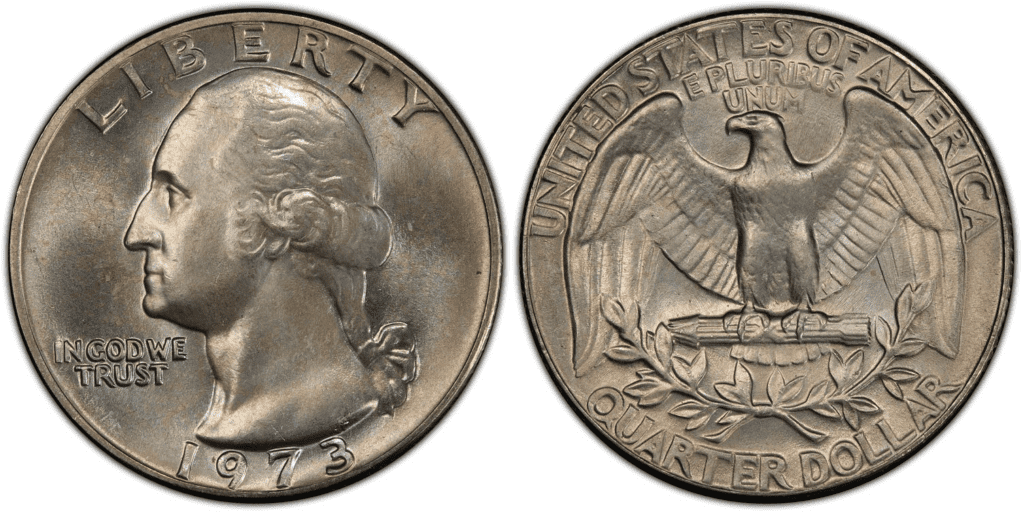
The 1973-P quarter should be easy to find, especially in a circulation condition. Of course, you can also find them in grades up to MS65. 1973-P quarters with grades MS66 and MS67 are scarce, but you should still find them in rolls and bags. However, at the time of this writing, no 1973-P quarter has been found to have a grade of MS67 or higher.
1973 D Washington Quarter
Year of minting: 1973
Mint Mark: D
Place of minting: Denver
Quantity produced: 232,977,400
Face Value: $0.25 (twenty-five cents)
Price: $9 or more (uncirculated condition)
Mass: 5.67 grams
Diameter: 24.30 mm
Edge: Reeded
Designer: John Flanagan
Composition: 75% Copper, 25% Nickel
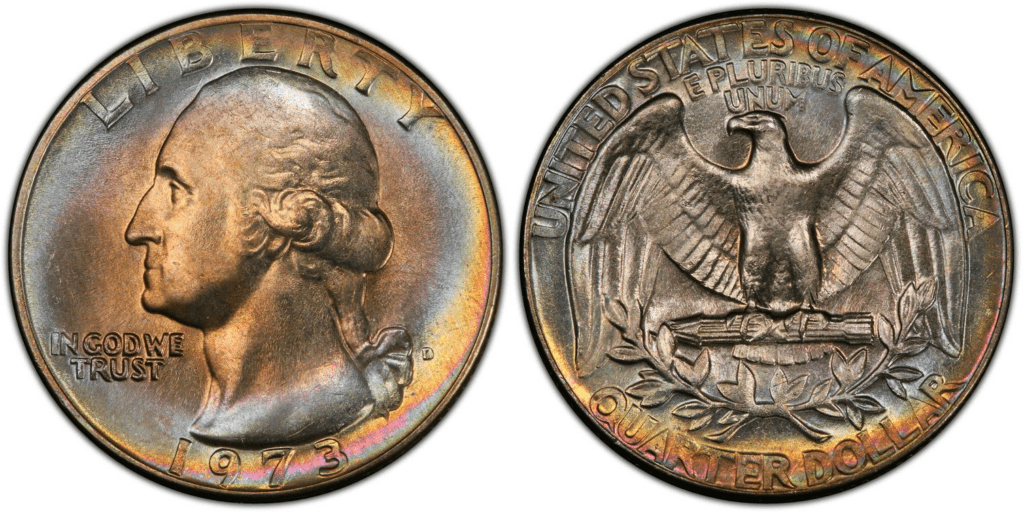
The Denver Mint produced more than 232 million quarters in 1973. This is lower than what was produced in 1972 and 1974.
1973 S Proof Washington Quarter
Year of minting: 1973
Mint Mark: S
Place of minting: San Francisco
Quantity produced: 2,760,339
Face Value: $0.25 (twenty-five cents)
Price: $7 (circulated condition)
Mass: 5.67 grams
Diameter: 24.30 mm
Edge: Reeded
Designer: John Flanagan
Composition: 75% Copper, 25% Nickel
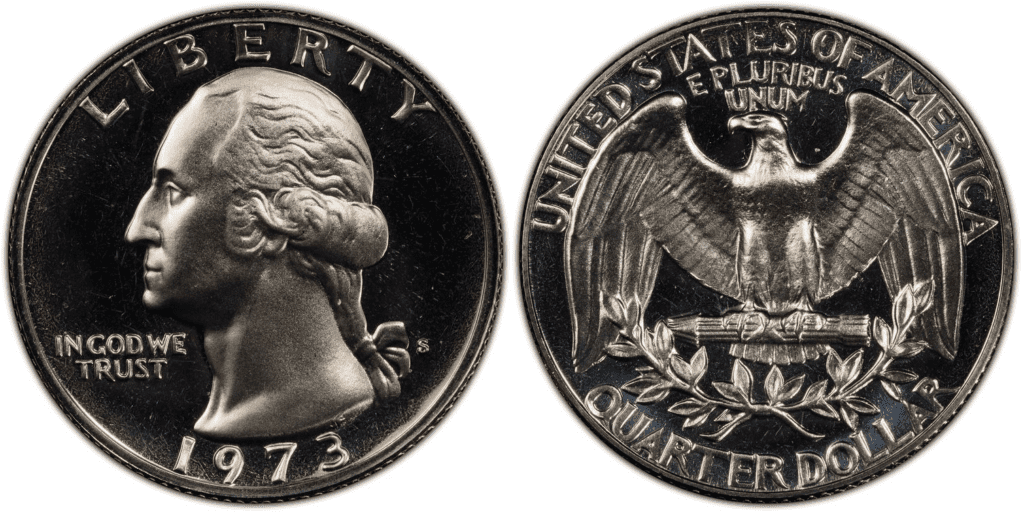
The San Francisco Mint produced over 2.7 million proof quarters in 1973, attesting to how the proof coins have become popular. The SF Mint did a great job in producing high-quality proof 1973 quarters. So, you should easily find them in grades up to PR69. However, 1973-S proof quarters in PR70 condition are hard to find.
List Of 1973 Washington Quarter Errors
The 1973 Washington quarter has its fair share of error coins. Although error coins are something you don’t want to happen in the minting process, they are valuable in the eyes of collectors. So, if you’re thinking of adding a 1973 quarter error coin to your collection, then check out the examples below:
Missing clad layer
The 1973 quarter has a pure copper core clad with nickel on the outside. Sometimes the coin was improperly minted and didn’t have the nickel covering it.
Here’s an example of a missing clad layer on a 1973 quarter coin:
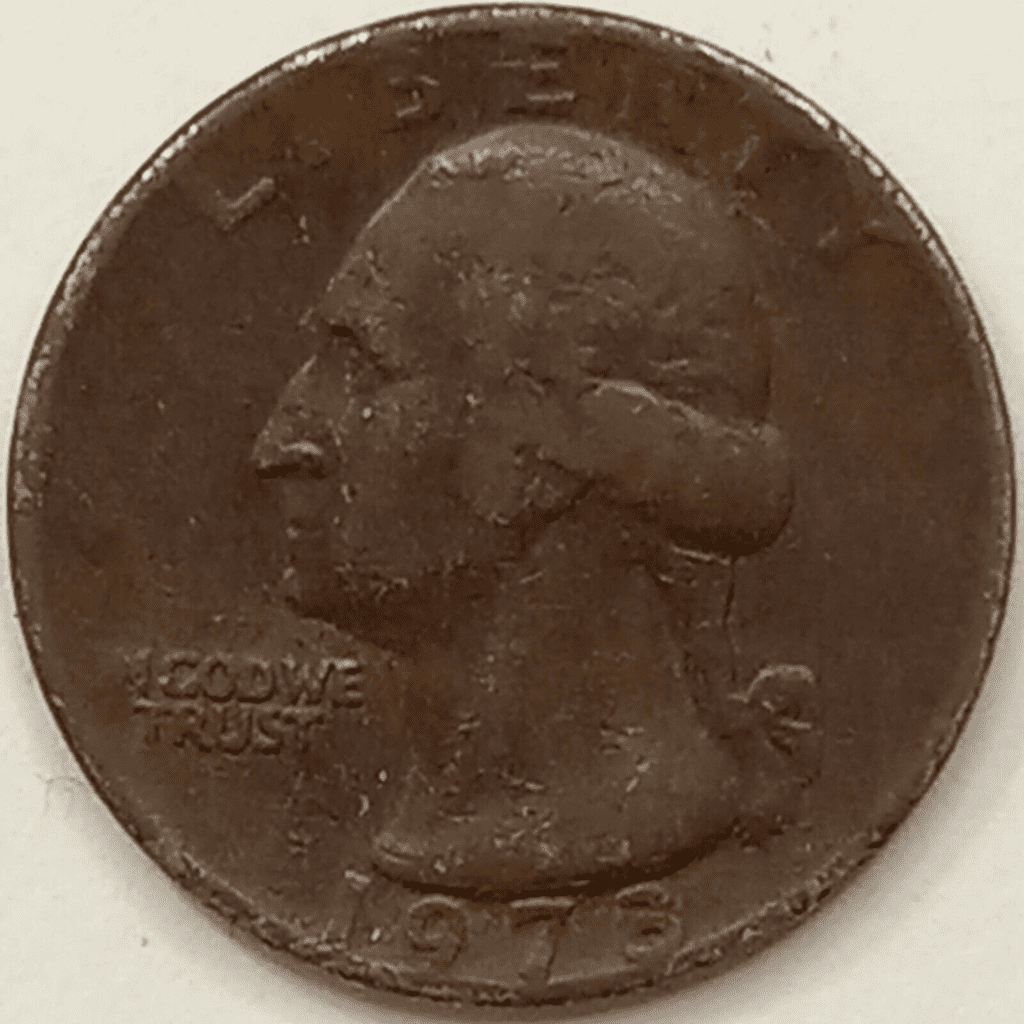
Strike-through error
The strike-through error happens when a foreign object sticks to the die or planchet. The foreign object can be dust, dirt, grease, metal clippings, or a cloth. The die strikes the planchet through the foreign object, creating different distortions on the coin’s surface.
Here’s an example of a strike-through error on a 1973 quarter:
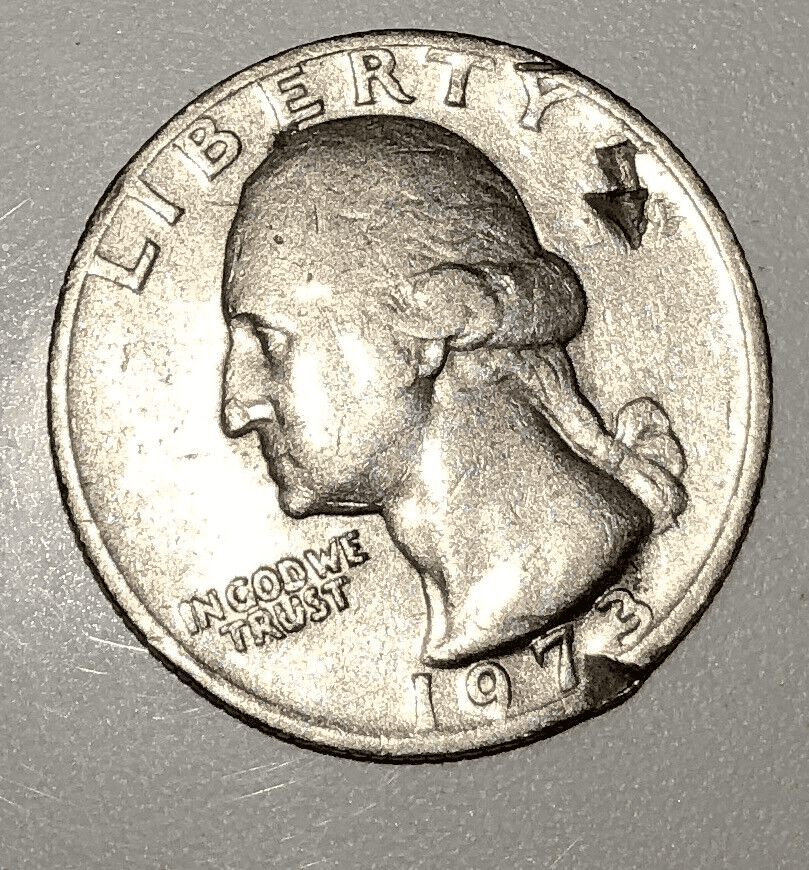
Weak strike
The die should hit the planchet with full force to engrave all elements with greater detail. However, the die didn’t deliver the full force due to mechanical error, leaving the coin smudgy. It would lack the necessary details on the engraved elements.
Take a look at this 1973 quarter, and how a weak strike makes the letters in “IN GOD WE TRUST” look smudgy:
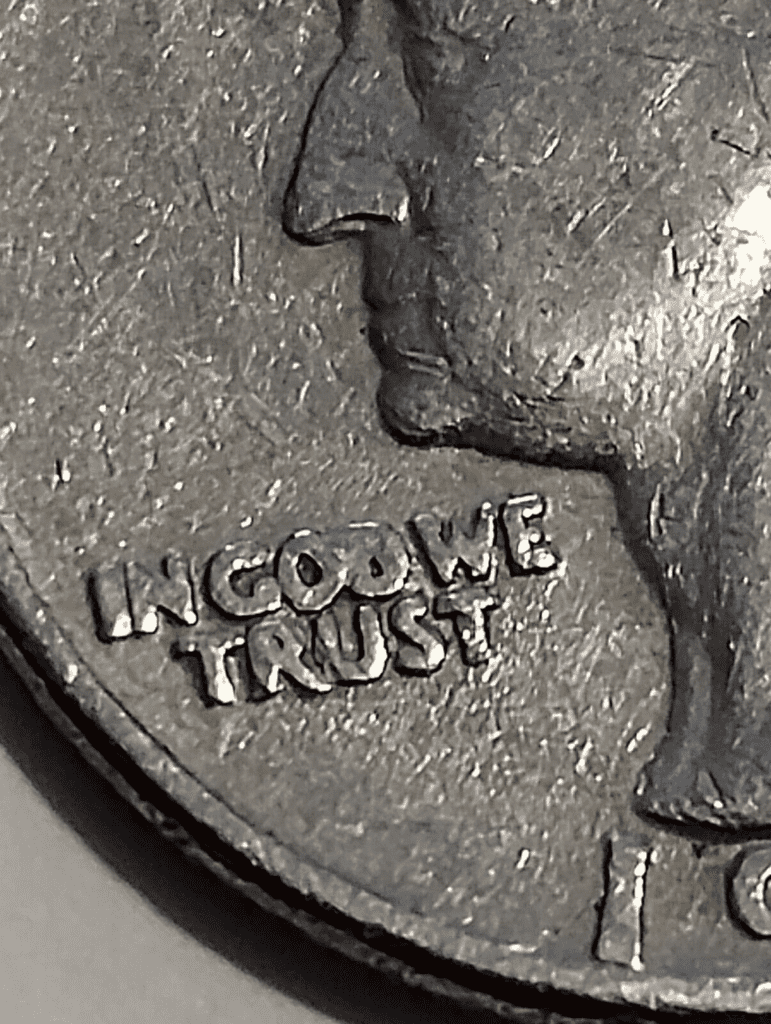
How Much Is 1973 Washington Quarter Worth Today?
The 1973 Washington Quarter should be affordable and not cost you an arm if you buy a coin in circulated condition. An ordinary 1973 Washington Quarter should not cost you more than one dollar.
The 1973 quarter doesn’t have silver in it. So, you would most likely trade it at its face value of 25 cents. Its melt value is higher at $0.0571.
Nevertheless, some valuable 1973 Washington quarters are rare and in good condition. Take a look at this auction records to know more about its value:
| Coin | Condition | Grade | Sold date | Sold by | Value |
| 1973 D Washington Quarter | Superb Gem Uncirculated | MS 68 | August 29, 2022 | eBay | $2,750 |
| 1973 P Washington Quarter | Superb Gem Uncirculated | MS 67 | May 19, 2013 | Great Collections | $1,486 |
| 1973 S Proof Washington Quarter | Perfect Uncirculated | PR 70 – Deep Cameo | February 16, 2017 | Heritage Auctions | $5,875 |
How Does The Grading System Work?
The 1973 quarter is graded in the same way as other coins in the United States.
Professional numismatists joined in the 1970s and established CoinGrading standards, known as the Sheldon Scale. These numismatists now assign grades at key places on the seventy-point scale, using the most regularly utilized numeric points in conjunction with the original adjective grade. The following are the most common coin grades:
- (P-1) Poor – Indistinguishable and probably damaged; if used, must have a date and mintmark; otherwise, rather battered.
- (FR-2) Fair – Nearly smooth, but without the damage that a coin graded Poor often possesses. The coin must have enough detail to be identified.
- (G-4) Fair – Inscriptions have merged into the rims in some areas, and important elements have been mostly erased.
- (VG-8) Very Good- A little weathered, but all primary design elements are visible, albeit faintly. There is little, if any, central detail left.
- (F-12) Good – The item is very worn, yet the wear is even, and the overall design details stand out clearly. Rims are almost completely isolated from the field.
- (VF-20) Very Fine – Moderately weathered, with some finer features still visible. The motto or all letters of LIBERTY are readable. Both sides of the coin have entire rims separated from the field.
- (EF-40) Extremely Fine – Gently used; all gadgets are visible, and the most important ones are bold. The finer details are bold and clear; however, light wear may be seen.
- (AU-50) Uncirculated – Slight evidence of wear on the coin’s design’s high points; it may have contact marks; eye appeal should be adequate.
- (AU-58) Uncirculated Choice – Slight traces of wear, no severe contact marks, almost full mint shine, and great eye appeal.
- (MS-60) Mint State Basal – Strictly uncirculated; no indication of wear on the coin’s highest points, but an unsightly coin with reduced luster, visible contact marks, hairlines, and other flaws.
- (MS-63) Mint State Acceptable – Uncirculated, but with contact scratches and nicks, little reduced shine, but otherwise appealing appearance. The strike is weak to average.
- (MS-65) Mint State Choice – Uncirculated with great mint shine, little contact blemishes, and exceptional eye appeal. The strike is unusually severe.
- (MS-68) Mint State Premium Quality – Uncirculated with superb luster, no obvious contact marks to the naked eye, and exceptional eye appeal. The strike is quick and appealing.
- (MS-69) Almost Perfect Mint State – Uncirculated with perfect brilliance, a sharp and appealing strike, and extremely good eye appeal. A near-perfect coin with minor imperfections in the planchet, strike, and contact markings (seen only under 8x magnification).
- (MS-70) Mint State Perfect – Under 8x magnification, no tiny imperfections are discernible; the strike is crisp, and the coin is perfectly centered on a beautiful planchet. Rarely seen on a coin, this coin is bright and whole, with original luster and exceptional eye appeal.
Where To Buy Or Sell 1973 Washington Quarter?
The 1973 Washington Quarter should readily be available in coin shops. Check the yellow pages or directories to look for coin dealers in your area. You can also use Google Maps, where the locations of coin shops are already listed.
Auctions are also an important source of the 1973 Washington quarters. If you can, try to join local or national clubs or groups of coin collectors. The more people you know, the more chances you’ll get in buying or selling 1973 Washington quarters.
Of course, living in this day and age, you can find 1973 Washington Quarters online. You can visit eBay, Amazon, Etsy, and other websites specializing in buying and selling coins.
FAQs
What is a mint mark on a 1973 quarter?
The mint mark on a 1973 quarter is on the obverse side of the coin. Look for it near the tip of Washington’s pigtail. The mint mark can either be D or S.
How much is a 1973 no mint mark quarter worth?
The 1973 no mint mark quarter is worth less than one dollar. However, the rare 1973 no-mint mark quarter can be worth more than its face value. For example, a 1973 P Washington Quarter was sold on May 19, 2013, with a grade of MS 67 for $1,486.
How much silver does a 1973 quarter have?
The 1973 quarter doesn’t have silver in it. Instead, it is composed of 75% copper and 25% nickel.
1972 Quarter Value Guide (Incld. Rare Varieties)
1972 Half Dollar Value Guide
1972 Dime Value Guide
1973 Jefferson Nickel Value Guide
1973 Lincoln Penny Value Guide (Incld. Rare Varieties)
1974 Washington Quarter Value Guide
1974 Kennedy Half Dollar Value Guide (Incld. Rare Varieties)
